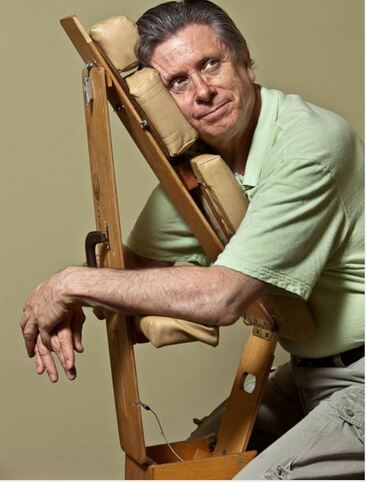Chair Massage - 16 NCBTMB approved CE Hours
|
Activities
Day 1
Day 2
Day 1
- Introduction to the history and function of chair massage.
- Instructor role-plays a verbal client screening and discusses screening guidelines.
- Sample written screening forms are described and discussed.
- The importance of practitioner intention and client expectation is discussed.
- Hygiene considerations are outlined and discussed.
- Instructor demonstrates the complete 15-minute sequence and discusses appropriate body mechanics, application of pressure, and acupressure theory.
- Discussion of client feedback system.
- Instructor demonstrates and students practice percussion techniques on themselves.
- Instructor demonstrates and students practice on each other the percussion sequence on the back.
- Instructor demonstrates the 3-minute shoulder sequence.
- Instructor supervises and gives feedback while students practice the 3-minute shoulder sequence on each other.
- Demonstrate and practice the body mechanics of using the body weight, not strength, to apply pressure.
- Discuss the client feedback system for application of pressure.
- Instructor demonstrates the “palm press” technique and students practice on each other down the back using appropriate body mechanics with instructor feedback.
- Instructor demonstrates location of 16 acupressure points on the shoulder and the “elbow press” technique. Students practice on each other with instructor feedback.
- Instructor demonstrates the “duckbill squeeze” technique on the arm. Students practice on each other with instructor feedback.
- Instructor demonstrates location of 2 acupressure points on the hand and the “wrist squeeze”, “hand spread”, “thumb stroke”, “thumb jiggle”, “coin rub”, “finger snap”, and “arm stretch” techniques. Students practice on each other with instructor feedback.
Day 2
- Instructor demonstrates location of 13 acupressure points on the back and the “2-thumb press” technique. Students practice on each other with instructor feedback.
- Instructor demonstrates location of 3 acupressure positions on the hips and the “hip stroke” and back brushing technique. Students practice on each other with instructor feedback.
- Instructor demonstrates location of 5 acupressure points on the neck and the “wrist drop” thumb pressure technique and neck stretch. Students practice on each other with instructor feedback.
- Instructor demonstrates the “10 finger massage”, “crab grab”, and “cupped hand” percussion techniques on the scalp. Students practice on each other with instructor feedback.
- Instructor reviews the complete sequence and the screening procedure. The students practice the whole sequence four times on each other under instructor supervision.
- Instructor demonstrates the various other ways to position a client when there is no massage chair available.
Each MT should bring the following:
Water bottle to stay hydrated throughout the day.
Breakfast and lunch will be provided, but if you want to bring your own, a refrigerator and microwave will be supplied.
Mask(to wear)
Water bottle to stay hydrated throughout the day.
Breakfast and lunch will be provided, but if you want to bring your own, a refrigerator and microwave will be supplied.
Mask(to wear)

ABOUT THE INSTRUCTOR
David Palmer
“David may not have been the first to discover Chair Massage, but, like Columbus, there is no doubt that he was the first to put it on the map.”
That was the perspective of Scott Lamp, President of the American Massage Therapy Association, in November 1997, when he chose to honor David Palmer with the prestigious President’s Award for his contribution to the massage profession.
In 1997, Massage Magazine hailed David as the “father” of contemporary Chair Massage for the significant role that he has played in the growth of one of the most ubiquitous segments of the bodywork services industry. In 2007, David was inducted into the Massage Therapy Hall of Fame.
David began his professional massage career in 1980. Before his teacher, Takashi Nakamura, returned to Japan in 1982, he prepared David to assume operation of The Amma Institute. The Amma Institute was the first school in the United States exclusively devoted to traditional Japanese massage. It was here that David first began experimenting with teaching his graduates to work on clients seated in a chair, rather than lying on a table. In 1989 David stepped down as Director of the school to focus full-time on the development of the Chair Massage industry.
Developer, the first chair for seated massage
In 1983, David began work on the first special chair to make seated massage comfortable and convenient for both the customer and the practitioner. In 1986, his chair was introduced to the bodywork profession by Living Earth Crafts and has served as the basic model for all subsequent massage chairs. To date there are over fifteen massage chairs and tabletop units on the market that have been sold to hundreds of thousands of practitioners worldwide. David currently works with Stronglite manufacturing company to develop and maintain the best massage chair on the market.
Author
David has written extensively about Chair Massage and the massage industry in general. His book, The Bodywork Entrepreneur, was used as a standard business text in bodywork schools during the 1990’s. He also developed Marketing Chair Massage, which is considered the best primer on the subject in the field. David has had numerous articles published in Massage Therapy Journal, Massage Magazine, Massage & Bodywork and industry newsletters.
Lecturer
David is a frequent keynote/banquet speaker and presenter at a wide variety of local, national, and state massage conferences and conventions including the American Massage Therapy Association, the Florida State Massage Therapy Association, the Alberta Massage Therapy Association, and the AMTA Chapters in California, New York, New Jersey, Ohio, and Texas. He is often invited to be on industry panels and conferences to contribute his unique point of view on current issues.
